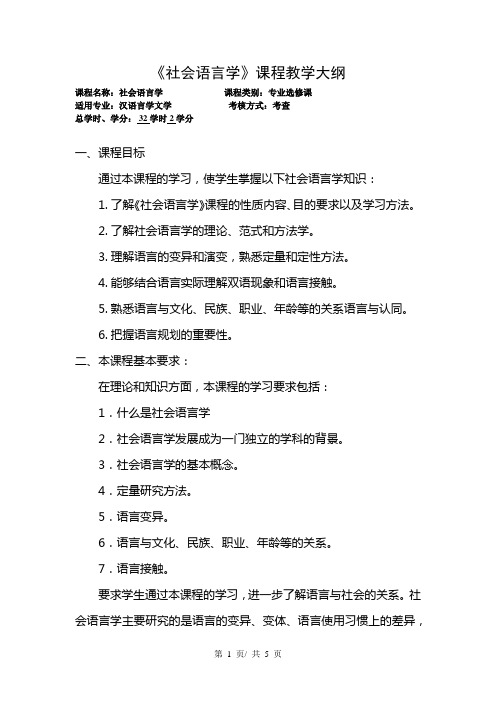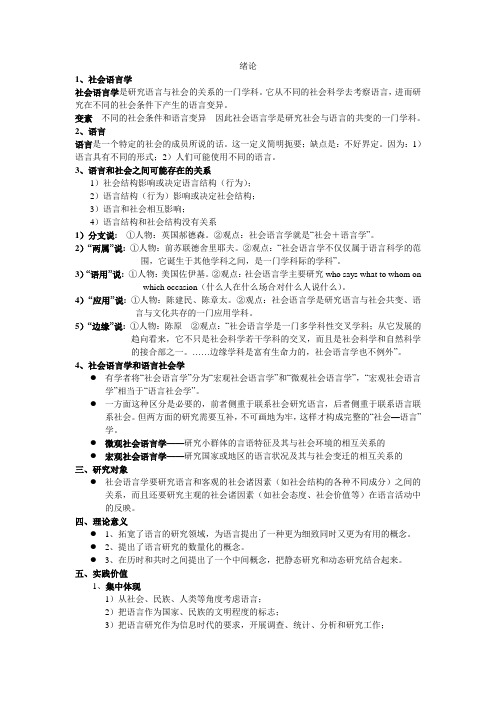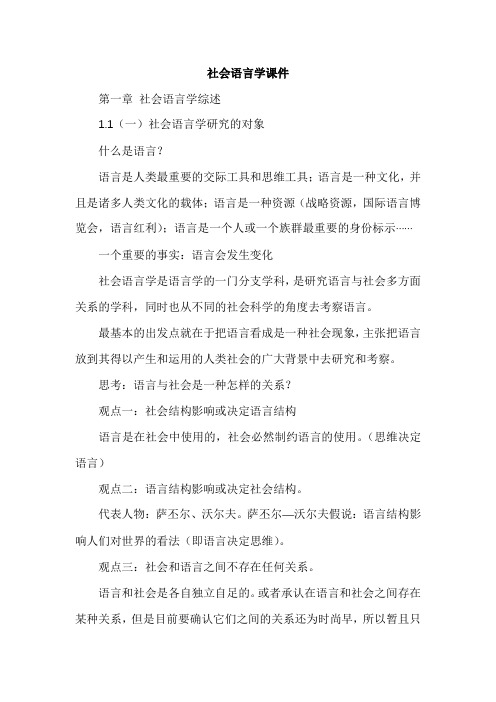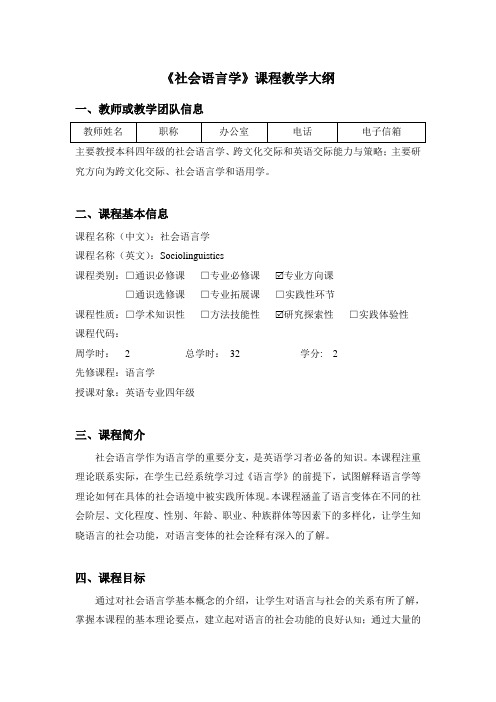社会语言学第十一章 作业上课讲义
【PPT】社会语言学

五、怎样学习社会语言学
• • • • 基本理论的学习 社会语言现象的个案调查分析 语言田野调查方法 课堂讲授+田野调查+课堂讨论三结合
六、教学主要参考书
教材: 教材: • 《中国社会语言学》(增订版) ,郭熙,浙江大 学出版社,2004 主要参考书: 主要参考书: • 社会语言学导论,陈松岑,北京大学出版社, 1985 • 社会语言学,陈原,学林出版社,1983 • 社会语言学概论,祝畹瑾,湖南教育出版社, 1992 • 社会语言学概论,戴庆厦,商务印书馆,2006
思考与练习
1. 观察一个方面(领域、专题、片段的)的 社会语言应用,分析影响社会语言应用的 主要因素。
社会语言学
一、什么是社会语言学
• 研究社会与语言的共变的一门学科。 • 研究语言在社会环境中的变异现象的 学科。 • 研究语言在社会环境中的存在、使用、 变化的情况
斯大林:《马克思主义与语言学问题》 语言是属于社会现象之列的,从有社 会存在的时候起,就有语言存在。语言随 着社会的产生和发展而产生和发展。语言 随着社会的死亡而死亡。社会以外是没有 语言的。因此要了解语言及其发展的规律, 就必须把语言同社会的历史,同创造这种 语言、使用这种语言的人民的历史密切联 系起来研究。
三、社会语言学的学习意义
1. 加深了对语言本体的研究 改变了对语言纯符号性质的象牙塔式的研 究。 2. 拓展了社会语言现象的认识 例:方言——普通话——国际通用语 3. 有助于对社会问题的解剖 例:民族身份的认定
四、学习社会语言学需要的相关知识
1. 语言学、语用学、方言学知识 2. 文化学、社会学、历史学、人类学知识 3. 的 语言内容;也可以说,语言的内容在足以 反映出某一时代社会生活的各面影。社会 的现象,由经济生活到全部社会意识,都 沉淀在语言里面。
语言学第十一章

language,mother tongue和 native language的共同特点是: (1)最早习得的语言,常常是在家 庭环境中学习; (2)熟练程度高,语言直觉强。
first
language,foreign language 的共同特点是: (1)是一种双语现象; (2)在掌握的时间顺序上次于第一语言; (3)熟练程度一般不如第一语言; (4)习得方式一般是学校教育、家庭教育 或自学。
What
elements of language are most amenable to Focus on Form? 哪些语言成分最适合通过“关注语言形 two variables (两个变量): (1) the relevance of universal 式”的途径来学习?
grammar (普遍语法的相关度) (2) complexity of language structures (语言结构的复杂度)
second
在语言环境方面,第二语言与外语有着根本
的差别。第二语言学习者般都有一个比较自然 的语言环境。周围有众多的该语言的本族语使 用者。该语言可能是“官方语言的一种(如法 语在加拿大,英语在印度等)。” 而“外语” 学 习者一般来说则很难有这样的语言环境。
第二语言和外语学习者所能掌握的语言
to Jo McDonough, a teacher who is able to explain some linguistic features would have a stronger position than one who handles the argument by using authority – "it's like that", "it's an exception", or "it's less formal".
《社会语言学》课程教学大纲

《社会语言学》课程教学大纲课程名称:社会语言学课程类别:专业选修课适用专业:汉语言学文学考核方式:考查总学时、学分: 32学时 2 学分一、课程目标通过本课程的学习,使学生掌握以下社会语言学知识:1.了解《社会语言学》课程的性质内容、目的要求以及学习方法。
2.了解社会语言学的理论、范式和方法学。
3.理解语言的变异和演变,熟悉定量和定性方法。
4.能够结合语言实际理解双语现象和语言接触。
5.熟悉语言与文化、民族、职业、年龄等的关系语言与认同。
6.把握语言规划的重要性。
二、本课程基本要求:在理论和知识方面,本课程的学习要求包括:1.什么是社会语言学2.社会语言学发展成为一门独立的学科的背景。
3.社会语言学的基本概念。
4.定量研究方法。
5.语言变异。
6.语言与文化、民族、职业、年龄等的关系。
7.语言接触。
要求学生通过本课程的学习,进一步了解语言与社会的关系。
社会语言学主要研究的是语言的变异、变体、语言使用习惯上的差异,七、课程教学内容第一章什么是社会语言学(4学时)(支撑课程目标1)1.教学内容(1)社会语言学的产生;(2)社会语言学的研究对象和研究任务;(3)社会语言学的研究意义和研究价值;(4)我国社会语言学研究概况;(5)社会语言学的定量研究方法。
2.重、难点提示认识社会语言学的现实意义及应用价值,认识到作为外部语言学的社会语言学和作为内部语言学的古代汉语、现代汉语、语言学概论等课程的区别,认识到语言学与社会学、文化学、人类学及其他学科的交叉关系。
第二章语言与文化(8学时)(支撑课程目标2)1.教学内容(1)语言与文化的关系;(2)亲属称谓与亲属制度;(3)颜色词的象征意义;(4)人、店、商标、文题命名体现的文化内涵及其命名规则;(5)语言对文化的制约和影响。
2.重、难点提示语言与文化的关系;现代社会人命带来的社会问题及其解决对策;颜色词象征意义的民族性。
第三章语言与民族(6学时)(支撑课程目标4)1.教学内容(1)语言与民族的关系;(2)语言与民族感情;(3)民族语言与文化生态;(4)民族语言所反映的民族文化。
社会语言学讲稿(课堂PPT)

1964年以后,社会语言学就迅速发展起来。有 人把社会语言学的产生和发展标为“知识革 命”(intellectual revolution)。1966年起,美国的 社会语言学家开始进行有计划的、综合性的大 规模实验研究,主要课题是黑人和少数民族的 语言问题。到了70年代,对社会语言学的理论 进行了总结。70年代以后,应用方面的研究工 作做得比较多,同时对提出的种种理论加以深 入的研究和修整。80年代以后,社会语言学就 比较成熟了。
19
至今,社会语言学已出现了许多研究著作、提出了 许多理论模式、解决了不少问题。社会语言学方面 还有一些专门的杂志,如International Journal of the Sociology of Language (主编J.A.Fishman), Language in Society(长期以来由D.Hymes主编,后 由W.Bright接任)都有了几十年历史。较新的社会 语 言 学 杂 志 有 Language Variation and Change, Journal of Sociolinguistics等等。许多以双语为专题 的杂志也属于社会语言学的性质。此外,大部分在 语言学界公认为影响较大的非专题性语言学杂志, 如 Language : Journal of the Linguistic Society of America, The BritishJournal of Linguistics 等等,也 常常发表社会语言学的文章。
8
§1.1 社会语言学的兴起
社会语言学(sociolinguistics)是在20世纪60年代在美国首先 兴起的一门边缘学科。它的诞生既顺应了时代发展的需要, 又弥补了传统语言学的不足。有些学者倾向于把它称为现 代社会语言学,意在指出对社会语言问题的研究远非自本 世纪下半叶才开始。但是大多数学者公认,社会语言学被 确立为一门独立的学科,获得普遍的承认和比俜⒄沟木置 娌沤鲇20多年的历史。这表现为不少国家设立了社会语言 学的学术机构,出版了大量的专著和文集,在大学里开设 了专题课程,培养出一支专门的研究队伍以及召开国际学 术会议、出版国际专业刊物等等。
《社会语言学》课程教案

社会语言学在教育领域中的应用
指导语言教学
社会语言学可以指导语言教学,帮助教师更好地理解学生的语言 习得过程,提供有效的教学方法和策略。
培养学生的语言意识
通过学习社会语言学,学生可以更加自觉地关注语言的使用和变化, 培养对语言的敏感性和批判性思维能力。
包括语言地位规划、语言教育规划、语言传播规划、语言 服务规划等。
包括调查研究、制定规划、宣传推广、实施评估等。
语言规划的评价标准与意义
评价标准
包括科学性、系统性、可行性、效果性等。
意义
对于促进语言发展、维护语言多样性、提高语言交流效率、增强国家文化软实力等方面 具有重要意义。
06 社会语言学在实际生活中 的应用
语言使用的场合与功能
不同场合的语言使用
人们在不同的场合会使用不同的语言,如在正式场合使用正式语言,在非正式 场合使用非正式语言。
语言的功能
语言具有多种功能,如交际功能、表达功能、认知功能等。人们在不同的场合 使用语言时,会根据需要选择不同的语言功能。
语言使用中的性别差异
词汇选择
男性和女性在词汇选择上可能存 在差异,如女性可能更倾向于使
研究意义
社会语言学的研究有助于我们更好地理解语言在社会中的作用和影响,为语言规划、语言教育、跨文化交际等领 域提供理论支持和实践指导。同时,社会语言学也促进了语言学与其他学科的交叉融合,推动了语言学理论的创 新和发展。
03 语言变异与语言使用
语言变异的定义与类型
定义
语言变异是指语言在使用过程中,由于各种因素的影响而产生的语言形式或使用上的差异。
《社会语言学》课件

社会语言学与其他语言学分支的关系
语音学
研究的是音的结构和音位、音素的分析和 音变过程,是对语音层面进行的学科研究。
词汇学
研究词汇和词的结构,其中也有一部分是 有关词的功能,如词类和句法等。
句法学
研究句子的基本成分、结构和组织规律, 以及句子与其他语言要素的关系。
语义学
研究语言符号的意义体系和语境下意义的 传达方式,还包括语义变化及其原因的研 究。
社会语言学的应用
社会语言学的一大应用领域是语言教学和语言规范的制定。在企业和商业领 域中,社会语言学的应用广泛,尤其是在市场营销等方面。
结论和展望
社会语言学自从上个世纪70年代以来快速发展,现在已经成为语言学中盛行的主流学门。我们期 待在更多领域和方向上研究社会语言学的贡献。
分析表情符号在社交互动中扮演的角色和意 义。
语言和身份
研究语言对身份认同和建构的影响,包括了 种族、地域、性、性取向等多个方面。
语码转换
研究多语言环境下的语码转换现象,反映了 语言使用者的个人经验和社会地位等多个方 面。
对话分析
研究人类社交对话的组织形式、话语闭合和 多样性等方面,也是社会语言学中热门的点 之一。
社会语言学的研究方法
观察
利用记录和分析自然语料库中的语言数据来发 现社会语言学规律和现象。
访谈
采用听取或录音的方式对人类语言进行评价、 描述和分析。
调查
通过问卷调查等方式采集语言使用情况和认知 数据。
语料库分析
对大量的语料进行计算机统计和分析,揭示语 言的统计规律和模式。
社会语言学的热门领域
表情符号
语言多样性ห้องสมุดไป่ตู้
研究社会和文化因素对语言多样性的影响,包 括方言、行话和异化等。
社会语言学讲义(学生版)

社会语言学讲义张林林编二0 0五年八月目录第一章绪论-----------------------------------------------------------------------------------(4)第一节社会语言学的兴起-----------------------------------------------------------(4)第二节社会语言学的对象和任务--------------------------------------------------(5)第三节社会语言学的内部分支-----------------------------------------------------(6)第四节社会语言学和其他学科的关系--------------------------------------------(7)第二章社会语言学的语言观--------------------------------------------------------------(8)第一节社会心理学派的语言观-----------------------------------------------------(8)第二节斯大林如何看待语言和社会的关系--------------------------------------(8)第三节社会语言学如何看待语言是一种社会现象-----------------------------(9)第三章语言和文化--------------------------------------------------------------------------(13)第一节语言间的差异和一致--------------------------------------------------------(13)第二节语言如何反映文化的内容--------------------------------------------------(14)第四章语言和民族--------------------------------------------------------------------------(16)第一节语言和民族的关系-----------------------------------------------------------(16)第二节双语现象-----------------------------------------------------------------------(17)第三节双语现象对语言结构的影响-----------------------------------------------(18)第四节我国政府的少数民族语言的政策-----------------------------------------(19)第五章社会变迁与汉语的发展-----------------------------------------------------------(20)第一节社会变迁与语言变化的关系-----------------------------------------------(20)第二节社会文化接触与汉语的发展-----------------------------------------------(21)第三节现代中国社会分化与当代汉语的发展-----------------------------------(23)第四节从“文革”语言看社会政治运动对语言的影响-----------------------(26)第五节社会人口的变动对语言的影响--------------------------------------------(28)第六章汉语和中国社会结构--------------------------------------------------------------(30)第一节语言对社会结构的反映-----------------------------------------------------(30)第二节语言对家庭的反映-----------------------------------------------------------(35)第三节人名-----------------------------------------------------------------------------(37)第四节地名-----------------------------------------------------------------------------(39)第七章当代语言变异理论-----------------------------------------------------------------(41)第一节变异和变素--------------------------------------------------------------------(41)第二节变体及其分类-----------------------------------------------------------------(45)第三节语言变异研究的方法论-----------------------------------------------------(50)第四节语言变异的研究方法--------------------------------------------------------(54)第八章语言变异材料的分析---------------------------------------------------------------(61)第一节引起语言变异的原因---------------------------------------------------------(61)第二节语体和语域——语言变异和社会因素的结合---------------------------(65)第三节语言接触所引起的语言使用上的变异------------------------------------(66)第四节语言接触所引起的语言结构上的变异------------------------------------(69)第九章语言变异研究成果的应用---------------------------------------------------------(72)第一节在共时变异中去寻找进行中的语言变化---------------------------------(72)第二节进行中的变化和年龄级差---------------------------------------------------(73)第三节从共时的变异中寻找进行中变化的方法---------------------------------(74)第四节语言变化的原因以及语言发展的趋势------------------------------------(74)第十章语言迷信------------------------------------------------------------------------------(75)第一节语言的功能与语言的神秘化------------------------------------------------(75)第二节禁忌语、委婉语和詈语------------------------------------------------------(78)第十一章社会语言学的研究程序和调查方法------------------------------------------(81)第一节社会语言学的研究程序------------------------------------------------------(81)第二节定性、定量研究以及抽样的方法------------------------------------------(83)第三节社会语言学研究人员的素养------------------------------------------------(85)第十二章社会语言学的应用---------------------------------------------------------------(87)第一节社会语言学和商业------------------------------------------------------------(87)第二节社会语言学和法律实践------------------------------------------------------(88)第三节社会语言学和医学------------------------------------------------------------(88)第一章绪论一、社会语言学的兴起社会语言学(Sociolinguistics)是上个世纪六十年代才兴起的一门新的学科。
社会语言学 复习资料 讲义

绪论1、社会语言学社会语言学是研究语言与社会的关系的一门学科。
它从不同的社会科学去考察语言,进而研究在不同的社会条件下产生的语言变异。
变素不同的社会条件和语言变异因此社会语言学是研究社会与语言的共变的一门学科。
2、语言语言是一个特定的社会的成员所说的话。
这一定义简明扼要;缺点是:不好界定。
因为:1)语言具有不同的形式;2)人们可能使用不同的语言。
3、语言和社会之间可能存在的关系1)社会结构影响或决定语言结构(行为);2)语言结构(行为)影响或决定社会结构;3)语言和社会相互影响;4)语言结构和社会结构没有关系1)分支说: ①人物:英国郝德森。
②观点:社会语言学就是“社会+语言学”。
2)“两属”说: ①人物:前苏联德舍里耶夫。
②观点:“社会语言学不仅仅属于语言科学的范围,它诞生于其他学科之间,是一门学科际的学科”。
3)“语用”说: ①人物:美国佐伊基。
②观点:社会语言学主要研究who says what to whom on which occasion(什么人在什么场合对什么人说什么)。
4)“应用”说: ①人物:陈建民、陈章太。
②观点:社会语言学是研究语言与社会共变、语言与文化共存的一门应用学科。
5)“边缘”说: ①人物:陈原②观点:“社会语言学是一门多学科性交叉学科;从它发展的趋向看来,它不只是社会科学若干学科的交叉,而且是社会科学和自然科学的接合部之一。
……边缘学科是富有生命力的,社会语言学也不例外”。
4、社会语言学和语言社会学●有学者将“社会语言学”分为“宏观社会语言学”和“微观社会语言学”,“宏观社会语言学”相当于“语言社会学”。
●一方面这种区分是必要的,前者侧重于联系社会研究语言,后者侧重于联系语言联系社会。
但两方面的研究需要互补,不可画地为牢,这样才构成完整的“社会—语言”学。
●微观社会语言学——研究小群体的言语特征及其与社会环境的相互关系的●宏观社会语言学——研究国家或地区的语言状况及其与社会变迁的相互关系的三、研究对象●社会语言学要研究语言和客观的社会诸因素(如社会结构的各种不同成分)之间的关系,而且还要研究主观的社会诸因素(如社会态度、社会价值等)在语言活动中的反映。
语言学概论,讲义第十一章 语言民族文化

第十一章语言与民族文化教学目的与要求了解语言就是一种文化,了解语言与文化的共性和差异、语言与文化的相互作用、了解怎么从语言现象透视民族文化第一节语言就是一种文化一、语言与文化的共性和差异1、语言和文化的含义(1)语言:从社会功能上看,语言是人类最重要的交际工具,思维工具,文化载体。
有广义与狭义之分,广义可以包括诉诸听觉的音乐语言和其他声音,狭义的“语言”就是语音符号系统(2)文化:广义文化指精神现象和物质的总和,也就是说人类所创造的物质成果和精神成果都是文化;狭义文化是指主要限于精神方面或非物质的现象2、语言和文化的异同共同点:(1)广义文化指人类的一切创造物,甚至包括由生物本能和生存需要而产生的自然行为都是人类有别于动物的文化表现,广义的语言也有别于其他动物的交际(2)各种文化都不是先天遗传的,而是后天得到的。
(3)各种文化,尤其是制度层面和心理层面的文化,在一个民族或社会内部都具有共享性,并不属于个人。
(4)所有的文化现象都具有符号作用和象征意义,有广义与狭义的区分(5)文化现象在某个社会中往往具有约定性和权威性差异性:(1)并非所有的文化现象都与语言直接相关(2)有些文化现象实际上又必须通过广义语言形式来表现(3)狭义语言和狭义文化这种相互联系的情况二、语言与文化的相互作用二者在发展中相互促进,互相作用1、语言是重要的民族标志,可以体现民族的精神2、语言有鲜明的民族特点,可以反映民族的文化3、民族文化有一定的推动力量,可能影响语言的形式语言在整体性质上具有文化的全部属性,语言就是一种文化;但同时语言和文化的作用范围不同,语言是文化的重要组成部分。
第二节从语言现象透视民族文化一、语言文字保存古代文化的遗迹1、文字中的文化线索语言的书写符号“文字”在民族文化的产生和发展过程中有着无可取代的重要作用。
(1)汉字可以看出古代生产方式的沿革甲骨文(2)汉字反映了古代风俗制度的变化(3)汉字反映了古代审美意识的发展2、词语中的文化信息词语负载了语言中表达意义的主要功能(1)词语的来源往往可以发现民族文化的踪迹(2)词语的构造可以看出民族文化的特征(3)词语的意义引申可以看出民族文化的发展3、特殊语言成分的文化含义(1)“数字”:数字词语各种语言都有,而且数量封闭(2)“人名、地名”:姓氏、从地名可以看出历史痕迹二、语言文字反映当代文化的变迁1、“吉祥话”的文化心里:从正面说一般就是靠“词语谐音”来“讨口彩”;从反面说就是“词语避讳”,不说不尊敬或不吉利的词语2、“称谓语”的时代特征:是一种人际关系的文化符号,可以分为亲属称谓、社会称谓、或者自称、谦称等,与亲属与相比表现更为复杂3、“广告语”的人文色彩:广义广告语包括商业广告,也包括公益广告和宣传警示标语,广告语逐渐称成为一种综合性艺术创作广告语的特点:(1)充分利用词语双关多义的特点,表达多层含义(2)利用了汉语的语义双关、谐音双关和比喻、比拟等修辞三、语言文字表现民族文化的互动1、文字的兴替与民族文化的影响一种文字可以记载一个民族古代文化的内容,文字的产生和消亡2、方言的分化与民族文化的扩散一种语言内部的分化可能形成不同的方言,方言分化记录了不同地域和社群文化的物质和心理特点;方言分化也反映了民族的文化变迁和历史状况3、词语的借用与民族文化的交流词语的借用可以发现不同民族文化交流的内容并且可以观察到不同民族文化交流的历史。
【推荐文档】社会语言学PPT

大纲
第一章、导论
第四章、语言和文化
社会语言学的研究范围和对象 语言与文化共生、共存
社会语言学的经典研究成果 亲属称谓与文化
社会语言学常用的研究方法 地名与文化
语言与民间心理(如禁忌、巫术、迷信、民俗等)
第二章、语言变异和语言变体 第五章、语言接触
社会方言
语言同化和文化同化
语言分化与语言转用
1.2 我关于广州话-k塞尾的调查研究
调查目的:了解广州话-k塞尾的演变规律
调查设计:调查材料由字表、词表和句子三部分组成。其中,字表以《 广州方言词典》单音字表里包含-k塞尾所有的声韵调组合字为基础,删 除一些不常用的字,个别生僻字换成了常见字。词表是把字表里带-k的 入声字组成词或短语,并保证带-k塞尾的入声字在词或短语的最后一个 音节上。最后我们把广州话中带-k塞尾的19个韵调跟个别声母拼合成 19个音节,各用一个字代替,并把这19个字分放到四个句子当中。
为什么以这样的方式说话。它试图从社会的 言语社区和言语交际能力
广义社会语言学的研究范围包括:
角度来解释某些语言的变项。其研究范围主 词表是把字表里带-k的入声字组成词或短语,并保证带-k塞尾的入声字在词或短语的最后一个音节上。
调查对象:60人,分成下工、中工、上工、下中、中中5个阶层。 言语事件(行为)的组成要素:
语言接触和词汇传播
语言演变的社会、文化原因 语言融合
第六章、社会发展和语言竞争
第三章、言语交际
大陆的语言竞争
言语社区和言语转换
台湾的语言竞争
语言或方言的可懂度研究
新加坡的语言竞争
第七章、社会语言学的应用
语言规划
语言教育和教育语言
第一章、导论
社会语言学课程讲义

社会语言学讲义周玉蓉参考书目:1、徐大明、陶红印、谢天蔚,《当代社会语言学》,北京:中国社会科学出版社,1997。
2、祝畹瑾,《社会语言学概论》,长沙:湖南教育出版社,1992。
3、祝畹瑾,《社会语言学译文集》,北京:北京大学出版社,1985。
4、陈松岑,《社会语言学导论》,北京:北京大学出版社,1985。
5、真田信治、涩谷胜己、阵内正敬、杉户清树著,王素梅、彭国跃译,《社会语言学概论》,上海:上海译文出版社,2002。
6、戴庆厦,《社会语言学教程》,北京:中央民族大学出版社,1993。
7、王德春、孙汝建、姚远,《社会心理语言学》,上海:上海外语教育出版社,1995。
8、Hudson ,R,A,Sociolinguistics . Cambridge: Cambridge University Press, 1980年。
9、刊物:《国外语言学》引言语言是什么一、语言的定义语言是什么——语言研究的理论、语言研究的目标、语言研究的范围、语言研究的范围、语言研究的途径、语言研究的方法、语言研究的重点、语言研究的结果、语言政策的制订等。
(一)语言定义例:列宁:语言是最重要的人类交际工具。
斯大林:语言是工具、手段,人们利用它来互相交际,交流思想,达到相互了解。
赵元任:语言是人跟人互通信息,用发音器官发出来的、成系统的行为方式。
《语言学纲要》:语言是人类最重要的交际工具,语言是思维工具,也是认识成果的贮存所。
《简明语言学词典》:语言是人类特有的交际工具、思维工具,也是人类特有的一种信息工具。
语言结构本身是音义结合的符号系统。
陈原:语言是一种社会现象。
语言是人类最重要的交际工具。
语言是人的思想的直接现实。
申小龙:说到底,语言不仅仅是一个交际工具或符号系统,语言本质上是一个民族的意义体系和价值体系,是一个民族的世界观。
洪堡特:从真正的本质上来看,语言是一件持久的事物,在每一个瞬间都稍纵即逝,即使通过文字保存下来的,也只是不完整的、木乃伊式的东西,只在描述当前话语时才重新需要。
社会语言学课件

社会语言学课件第一章社会语言学综述1.1(一)社会语言学研究的对象什么是语言?语言是人类最重要的交际工具和思维工具;语言是一种文化,并且是诸多人类文化的载体;语言是一种资源(战略资源,国际语言博览会,语言红利);语言是一个人或一个族群最重要的身份标示……一个重要的事实:语言会发生变化社会语言学是语言学的一门分支学科,是研究语言与社会多方面关系的学科,同时也从不同的社会科学的角度去考察语言。
最基本的出发点就在于把语言看成是一种社会现象,主张把语言放到其得以产生和运用的人类社会的广大背景中去研究和考察。
思考:语言与社会是一种怎样的关系?观点一:社会结构影响或决定语言结构语言是在社会中使用的,社会必然制约语言的使用。
(思维决定语言)观点二:语言结构影响或决定社会结构。
代表人物:萨丕尔、沃尔夫。
萨丕尔—沃尔夫假说:语言结构影响人们对世界的看法(即语言决定思维)。
观点三:社会和语言之间不存在任何关系。
语言和社会是各自独立自足的。
或者承认在语言和社会之间存在某种关系,但是目前要确认它们之间的关系还为时尚早,所以暂且只考虑语言本身。
观点四:社会和语言的影响是双向的、互动的。
社会语言学家普遍认同的一种观点:语言和社会之间存在互动关系,语言是社会的重要组成部分,在社会中被人们使用,是最重要的交际工具和思维工具,语言会对社会产生一定的影响;社会是动态发展的,人们处在不同的社会背景中,社会的各种因素和个人的不同特征也会对语言产生影响。
社会语言学强调语言和社会之间的紧密联系,关注语言和社会之间的双向作用,但重点是社会对语言的影响和制约。
社会语言学研究的根本立足点:承认语言和社会的紧密联系。
试图把语言从社会背景中剥离出来是困难的,也不是不可能的。
人们在交际过程中受到各种因素的影响,语言呈现出差异或变化,社会语言学家用“变异(variation)”这个概念来指称自己的研究对象,社会语言学研究的正是语言和社会之间的共变(co-variance)关系。
《社会语言学》课程教学大纲

《社会语言学》课程教学大纲一、教师或教学团队信息主要教授本科四年级的社会语言学、跨文化交际和英语交际能力与策略;主要研究方向为跨文化交际、社会语言学和语用学。
二、课程基本信息课程名称(中文):社会语言学课程名称(英文):Sociolinguistics课程类别:□通识必修课□专业必修课 专业方向课□通识选修课□专业拓展课□实践性环节课程性质:□学术知识性□方法技能性 研究探索性□实践体验性课程代码:周学时: 2 总学时:32 学分: 2先修课程:语言学授课对象:英语专业四年级三、课程简介社会语言学作为语言学的重要分支,是英语学习者必备的知识。
本课程注重理论联系实际,在学生已经系统学习过《语言学》的前提下,试图解释语言学等理论如何在具体的社会语境中被实践所体现。
本课程涵盖了语言变体在不同的社会阶层、文化程度、性别、年龄、职业、种族群体等因素下的多样化,让学生知晓语言的社会功能,对语言变体的社会诠释有深入的了解。
四、课程目标通过对社会语言学基本概念的介绍,让学生对语言与社会的关系有所了解,掌握本课程的基本理论要点,建立起对语言的社会功能的良好认知;通过大量的实际生活案例,使学生知晓语言变体在不同的社会语境因素下的多样化;课内和课外进行大量的实证研究,鼓励学生接触实际生活的案例,以理论联系实际的方式,让学生对语言与社会的密切关系有更深刻的感性认识。
五、教学内容与进度安排课程教学过程中,以教师的讲授和指导以及学生的阅读、讨论、探究、和实践为主要的课内教学环节,以学生的课前预习、课后复习、问题回答准备和学期研究项目等为主要的课外环节,整个教学过程贯穿师生的互动。
六、修读要求修读本课程的学生必须参加每次的课堂讨论、辩论、和学期研究项目,无故缺席两次,最终评分时扣10分。
学生按照作业要求完成每次口头和笔头作业,对引用他人观点必须注明出处,如有发现抄袭行为,也将影响最终的评估。
要求学生通过修读本次课程,培养独立思考和批判性思维等高阶认知能力,做到独立发表自己的观点,并能结合学到的相关理论进行较深层次的分析,充分展现出对于语言变体社会诠释的感知和理解。
《社会语言学》课程教学大纲经典版

《社会语言学》课程教学大纲经典版《社会语言学》课程教学大纲课程编码:50615001学分:2 总学时:36说明【课程性质】《社会语言学》为英语专业的专业必修课。
【教学目的】《社会语言学》课程是四年制本科英语语言文学专业的必修课,是一门介绍语言与社会的关系的重要选修课程,开课时间为第四学年第一学期,其前期和同期相关课程为《语言学导论》。
【教学任务】通过《社会语言学》这门课的学习,使学生了解到社会语言学是语言学中的重要研究领域分支之一,是一门研究语言与社会的关系的学问。
加强学生在英语语言学方面的知识储备,有利于学生学好其它英语专业课程。
【教学内容】《西方语言学与应用语言学视野:社会语言学导论(第3版)》共16章节,具体内容包括社会语言学家研究什么,多语社区中的语言选择,语言保持和语言转用,语言变体和多语国家,国家语言和语言规划。
【教学原则和方法】教学原则:本教材使用主要体现以人为本的思路,采取启发式教育方法,鼓励学生积极思考,在学习过程中发现和解决问题。
教学方法:讲授与讨论实践相结合。
【先修课程要求】语言学基本理论【学时分配】本课程在第八学期开设,共一学期,每周2学时,共36学时。
【教材及必要参考书】教材: 《社会语言学导论》, Janet Holmes, 世界图书出版公司, 2011年, 第三版。
参考书: [1]《社会语言学引论》, Ronald Wardhaugh, 外语教学与研究版社,2000。
[2]Sociolinguistics, Hudson R.A.,Beijing: Foreign Language Teaching andResearch Press , 2000.[3]《社会语言学论文集》, 祝畹瑾,北京大学出版社,1985。
大纲内容第一部分社会语言学概述【教学目的和要求】教学目的:了解社会语言学的基本理论。
教学要求:掌握社会语言学的基本理论。
【内容提要】第一节一、社会语言学家研究什么?二、何为社会语言学家?三、为什么我们用不同的方法表达同样的事情?四、我们表达事情的不同方法有哪些?五、社会因素、范畴和解释六、A部分多语社区【教学重点与难点问题】教学重点:社会语言学家研究范畴教学难点:社会因素、范畴和解释【复习思考题】1. 如何结束语言变异?第二部分多语社区中的语言选择【教学目的和要求】教学目的:多语社区中的语言选择教学要求:掌握语言选择。
- 1、下载文档前请自行甄别文档内容的完整性,平台不提供额外的编辑、内容补充、找答案等附加服务。
- 2、"仅部分预览"的文档,不可在线预览部分如存在完整性等问题,可反馈申请退款(可完整预览的文档不适用该条件!)。
- 3、如文档侵犯您的权益,请联系客服反馈,我们会尽快为您处理(人工客服工作时间:9:00-18:30)。
社会语言学第十一章作业Second Language Acquisition刘颖 13073080Second language acquisition is a general term which refers to the acquisition of a second language, in contrast with first language acquisition. SLA is also used as a general term to refer to the acquisition of a foreign or subsequent language. Thus, SLA is primarily the study of how learners acquire or learn an additional language after they have acquired their first language. According to Krashen, acquisition refers to the gradual and subconscious development of ability in the first language by using it naturally in daily communicative situations. Learning, however, is defined by Krashen as a conscious process of accumulating knowledge of a second language usually obtained in school settings.But there are some differences between acquisition and learning. According to Krashen, acquisition refers to the gradual and subconscious development of ability in the first language by using it naturally in daily communicative situations. Learning, however, is defined as a conscious process of accumulating knowledge of a second language usually obtained in school settings. A second language, Krashen argues, is more commonly learned but to some degree may also be acquired, depending on the environmental setting and the input received by the second language learner. A rule can be learned before it is internalized, but having learned a rule does not necessarily prevent having to acquire it later. For example, an English language learnermay have learned a rule like the third person singular "-s", but is unable to articulate the correct form in casual and spontaneous conversation because the rule has not yet been acquired. This shows that conscious knowledge of rules does not ensure an immediate guidance for actual performance. Contrastive Analysis was developed in order to identify and predict the areas of learning difficulty. Given this approach, it was hypothesized that second language errors were predominantly the result of negative transfer, or mother tongue interference and second language learning was believed to be a matter of overcoming the differences between first language and second language systems. According to this view, the major task of second language teaching should predominantly be: first, contrast the native and the target language systems and make predictions about the language items that would cause difficulty and the errors that learners were likely to make; then use these predictions in deciding on the type of language items that needed special treatment in teaching and in material development and the type of intensive techniques that would be employed to overcome learning difficulties created by the interference. In practice, the Contrastive Analysis is not effective because a large proportion of grammatical errors could not be explained by mother tongue interference. Errors predicted by contrastive analysis have often not occurred, whereas many actual errors come from overgeneralization instead of negative transfer. Errors, according to the contrastive analysis approach, are negative and had to be overcome or givenup. In fact, errors produced in a learner’s second language utterance may very well be developmental errors and therefore, should not be looked upon simply as a failure to learn the correct form, but as an indication of the actual acquisition process in action. Developmental errors often result from the effort on the part of the learner to construct and test general rules of communication in the target language.Interlanguage consists of a series of interlocking and approximate linguistic systems in-between and yet distinct from the learner’s native and target languages. It represents the learner’s transitional competence moving along a learning continuum stretching from one’s first language competence to the target language competence. As a type of linguistic system in its own right, interlanguage is a product of second language training, mother tongue interference, overgeneralization of the target language rules, and communicative strategies of the learner. In principle, no human brain can store all the words and expressions of a language. What happens is that when processing the language they hear, children construct the grammar and make sense of the expressions according to the grammar. When producing utterances, they follow the internalized grammatical rules. Without the knowledge of the productive rules, it would be impossible for language users to produce and understand an unlimited number of sentences which they have never heard before. Language acquisition is a genetically determined capacity that all humans possess. Although the development of acommunicative system is not unique to human beings, the natural acquisitionof language as a system of highly abstract rules and regulations for creative communication distinguishes humans from all other animal species. In this sense, humans can be said to be predisposed, that is, biologically programmed, to acquire at least one language. Language development can thus be regarded as analogous to other biological developments in human growth and maturation, such as the growth and maturation of one’s limbs and organs. Humans are equipped with the neural prerequisites for language and language use, just as birds are biologically “prewired” to learn the songs oftheir species.At one time, it was widely believed that children learned language by simply imitating the speech of those around them. We now know that this cannot be true, since many utterance types produced by children do not closelyresemble structures found in adult speech. . If children learn their nativetongue by imitating their parents, how can we account for the utterances that are typical of children’s language, such as the plural form "my foots," the past tense forms of” I eated," and the negative construction of “No the sun shining”? It is impossible that children imitate these structures from adults because they are never heard in adult conversations. In addition, Children with speech impairment for neurological or physiological reasons learn the language spoken to them and understand what is said. A more reasonable explanationis that children are attempting to construct and generalize their own grammatical rules.Some young language learners do seem to make selective use of imitation, but they do not blindly mimic adult speech in a parrot fashion, but rather exploit it in very restricted ways to improve their linguistic skills. The point is that imitation plays at best a very minor role in the child’s mastery of langua ge.。
